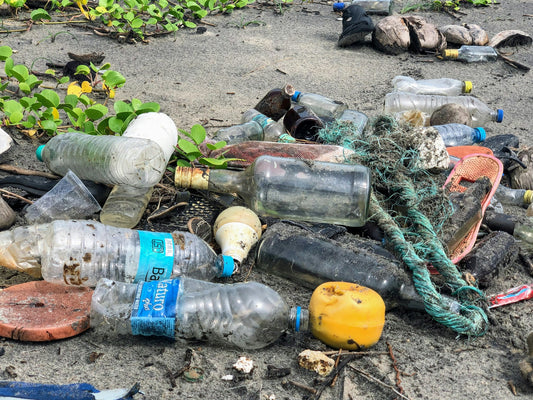Share
Plastic Pollution as the Challenge of Our Century
Plastic pollution is one of the main challenges of our century. In the last 10 years, the world produced more plastic than in the whole century before that. And it’s getting worse every year. According to the United Nations, plastic pollution is forecast to double again until 2030.
If we ever want to tackle this problem, we need to find alternatives to mainstream plastic products. Yes, recycling, cleanups and scientific enhancements in reducing the impact of plastic on our nature can play an important role. But the only thing that can really make an impact is a major reduction in plastic production in the first place.
Luckily, there are many fantastic alternatives to single-use plastic products that are affordable, convenient, and sometimes even better than their plastic twins. One of these great materials is Loofah. The natural material has been used for millennia and we are confident that it will be a lead player in fighting plastic pollution in the decades to come. But wait a minute…What the heck is loofah in the first place?
What is Loofah?
A quick search in the Britannica online encyclopedia reveals that loofah, sometimes called loofa or luffa, is a vine from the family of gourds that also include melons, cucumbers, and squashes. If you look at the picture below, this does not come as a surprise, as this loofah could easily be mistaken as a giant cucumber.

The main two species globally are the smooth loofah (Luffa acutangula), which you see in the above picture, and the ridged loofah (Luffa aegyptiaca), which is the more rough and "edgy" twin (don't we all know that rough and edgy sibling ;-)). Both species are cultivated for the same various purposes. In fact, the loofah plant is a true all-rounder that (rightly so!) has been used by diverse cultures all over the world for millennia.
While the exact origin of loofah is unknown, most researchers believe the plant originated in Asia or Africa and was first cultivated in India. The plant was brought to the Americas as one of the first ever cultivated crops in the new world around 9000 (!) years ago.
Wow! 9000 years ago! What are people using it for?
What is Loofah Used for?
One of the reasons for the veggie’s success is its versatility. When the fruits are young and green, they make a tasty addition to Asian-inspired recipes and as an alternative to zucchinis, okras, or bitter melons. While the fruit itself is relatively mild, its “sponginess” makes loofah the perfect addition to curries or stews. Alternatively, you can use it as main veggie component in stir fries. This is especially delicious if you marinate the gourds before frying and add a little spiciness.
Later in the growing season, the gourds will slowly dry out on the vine. Once they are fully brown, they are harvested and processed.
- The gourds are peeled, and seeds are removed
- The plant is gut into pieces
- The pieces are washed and cleansed from dirt and dried out
Check out this Insider video if you’re interested how that looks like.
After the loofah is cleaned and dried makes, it makes the perfect material for sponges in the bathroom or kitchen.
Why are Loofah Sponges Better than Plastic Sponges?
There are many reasons, why loofah sponges are better than their synthetic counterparts. Natural sponges made from loofah have fantastic attributes that are in no way inferior to any plastic sponges you find in the grocery store.
The first (admittedly very obvious) thing to note is that the loofah sponge is completely biodegradable, which means it will not cause any damage to the environment. Considering that 400 million plastic sponges are thrown away in the US alone, you can only imagine, how big of an impact it would make if more people used loofah instead. Aside of the sponges that are thrown away, plastic sponges have also shown to release microplastics, when small pieces break off and go down the drain or even end up in our food. Environmental protection is not the only reason to swop your plastic sponge, though.
Other than plastic sponges, which get infected with bacteria in less than a week, loofah sponges are naturally antibacterial and anti-fungal, which makes them perfect for cleaning your dishes and your body. Pair that with loofah’s extreme durability and you can use your sponge up to multiple months if you care for it properly.
That, of course, depends on your usage. Especially if you use your loofah for your personal care routine, you should take proper care for it to avoid bacteria growing (see below). That applies to any sponge you use in the shower, as the scrubbed off skin particles paired with the humid and warm environment in the bathroom are a true wonderland for bacteria.
Natural loofah sponges also softer than plastic sponges, so they won’t scratch surfaces or irritate your skin. At the same time, they offer fantastic cleansing power, because of their porous surface that foams perfectly and traps dirt better than any plastic sponge we’ve tested.
How do I use a loofah sponge properly?
Use your natural loofah sponge like any other sponge. Soak it in water, apply natural soap, and rub it (like it’s hot?) against whatever surface you are cleaning.
After use, make sure to rinse the sponge well and squeeze it tightly to remove all remaining water. After that, dry the loofah completely and leave it dry and cold to prevent any bacteria to grow (bacteria love it humid and warm). Ideally, use a grid-like soap dish or hang the sponge, which facilitates the drying process.
Once every week, you should disinfect your loofah sponge using any of the following methods:
- Microwave it: rinse the loofah until soaking wet and microwave it for two minutes. Make sure that there are no small metal pieces stuck in the sponge, as metal must not be microwaved.
- Boil it: bring a large pot of water to boil. Insert the sponge and make sure it is fully covered in water. Boil for several minutes to kill any bacteria
- Wash it: put your loofah sponge in the dishwasher or washing machine
After all of these methods, make sure to squeeze and dry the loofah sponge again, as outlined above.
When and how should I dispose of my loofah sponge?
A loofah sponge can be used for multiple weeks or even months, depending on the frequency of use, what you use it for, and how well you care for it. Whenever you realize any mold or bad smell building up, it is time to say goodbye.
The good thing is that you can dispose of your loofah knowing that it won’t hurt the environment. Just cut it into small pieces and put it in the green bin. If you have a garden, you can even use it like coconut fiber, as it is excellent at water retention or growing seedlings. You can even use your loofah scraps to grow your own loofah for unlimited and infinite sponge and fruit supply. How cool is that?

We hope you enjoyed this article. If you want to read more like this, make sure to check out our Blog and follow us on Instagram. If you are interested in more sustainable eco SWOPs, check out our Shop.
Sources: britannica.com, UN.org, ncsu.edu, greenhousecanada.com








